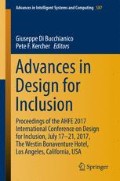Abstract
Fall is one of the major problems in the world’s ageing population. An ample amount of literature is available on different interventions that are practiced in developed countries as key tools to face the consequences derived from elderly fall. These includes: addressing personal behavior training, muscle exercise, technology interventions, and products like: hip-protectors, sole-sensors, fall detection, monitoring system etc. In developing countries like India similar approach may not be sufficient to overcome fall problem in elderly. This study is an initiative to understand the salient risk factors that influence Indian older adults’ perspective on fall problem and its related interventions. The study is carried out using qualitative method of research. Direct observation, in-depth interview with open-ended questionnaire is used and transcripts are analyzed using coding process. In India “Geographical Area”, “Financial Condition” and “Family Structure” plays an important role in the quality of elderly livelihood. Two other intermediate factors: “Awareness of elderly fall problem” and “Awareness of fall related intervention” and sub-categories like: “Willingness to perform exercise/use of other intervention”, “Fear of Falling (FOF)”, “Sense of security”, “Hesitation for taking help” and “Informal measure for fall” are emerged during the analysis process. Another factor influencing Indian elderly’s perception on fall and related intervention is the older adult’s concern about their ability as they are old. Before addressing Indian elderly fall and suggesting/designing/developing new tool or technique related to fall understanding of Indian older adults’ perspective on fall and its related intervention is very important.
Access this chapter
Tax calculation will be finalised at checkout
Purchases are for personal use only
References
Rao, S.S.: Prevention of falls in older patients. Am. Fam. Physician 72(1), 81–88 (2005)
Jeyalakshmi, S., Chakrabarti, S., Nivedita, G.: Situation Analysis of the Elderly in India. Central Statistics Office, Ministry of Statistics & Programme Implementation. Government of India (2011)
Rajan, S.I.: Population ageing and health in India (2006)
Huang, C.C., Sun, C., Wu, T.L., Sheth, C.: A pervasive way: elderly people falling detection and ambient intelligence. In: CHI (2010)
Dsouza, S.A., Rajashekar, B., Dsouza, H.S., Kumar, K.: Falls in Indian older adults: a barrier to active ageing. Asian J. Gerontol. Geriatr. 9(1), 1–8 (2014)
Mathur, A.: Contemporary Issues in the Health of the Elderly, pp. 38–43. http://www.apiindia.org/pdf/medicine_update_2007/7.pdf. Accessed 09 Oct 2014
Yein, N., Pal, S.: Technological assistance for fall among aging population: a review. In: Chakrabarti, A.C. (ed.) Research into Design for Communities, Volume 1. Smart Innovation, Systems and Technologies, vol. 65, pp. 409–419. Springer Nature Singapore Pte. Ltd. (2017). doi:10.1007/978-981-10-3518-0_36
Lavizzo-Mourey, R., Cox, C., Strumpf, N., Edwards, W.F., Lavizzo-Mourey, R., Stinemon, M., Grisso, J.A.: Attitudes and beliefs about exercise among elderly African Americans in an urban community. J. Natl. Med. Assoc. 93(12), 475 (2001)
Pappous, A., Cruz, F., De Leseleuc, E., Marcellini, A., Recours, R., Schmidt, J.: Attitudes of the elderly toward physical activity and exercise. Adaptation of the older person’s attitudes toward physical activity and exercise questionnaire in Spain. Stud. Phys. Cult. Tourism 13(1), 69–77 (2006)
Chalabaev, A., Emile, M., Corrion, K., Stephan, Y., Clément-Guillotin, C., Pradier, C., d’Arripe-Longueville, F.: Development and validation of the aging stereotypes and exercise scale. J. Aging Phys. Act. 21(3), 319–334 (2013)
Wankel, L.M.: Exercise adherence and leisure activity: patterns of involvement and interventions to facilitate regular activity. In: Exercise Adherence: Its Impact on Public Health, pp. 369–396 (1988)
Author information
Authors and Affiliations
Corresponding author
Editor information
Editors and Affiliations
Rights and permissions
Copyright information
© 2018 Springer International Publishing AG
About this paper
Cite this paper
Yein, N., Pal, S. (2018). Qualitative Study on Salient Factors Influencing Indian Elderly’s Perception on Fall and Its Related Interventions. In: Di Bucchianico, G., Kercher, P. (eds) Advances in Design for Inclusion. AHFE 2017. Advances in Intelligent Systems and Computing, vol 587. Springer, Cham. https://doi.org/10.1007/978-3-319-60597-5_11
Download citation
DOI: https://doi.org/10.1007/978-3-319-60597-5_11
Published:
Publisher Name: Springer, Cham
Print ISBN: 978-3-319-60596-8
Online ISBN: 978-3-319-60597-5
eBook Packages: EngineeringEngineering (R0)

